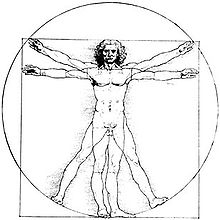Human Genome Project - Write
Appearance

The Human Genome Project - Write (also known as Human Genome Project-Write, Genome Project-Write and HGP-Write), formally announced on 2 June 2016, is a ten year extension of the Human Genome Project, to synthesize the human genome.[1][2][3][4][5][6] The human genome consists of three billion DNA nucleotides, which have been described in the Human Genome Project - Read program, completed in 2003. The newly created HGP-Write project will be managed by the Center of Excellence for Engineering Biology, a new nonprofit organization. The researchers expect that the ability to synthesize large portions of the human genome would result in many scientific and medical advances.[1][2][3][4][5][6]
See also
- 1000 Genomes Project
- Chimpanzee Genome Project
- ENCODE
- EuroPhysiome
- Genome Compiler
- HUGO Gene Nomenclature Committee
- Human Brain Project
- Human Connectome Project
- Human Cytome Project
- Human Microbiome Project
- Human proteome project
- Human Variome Project
- List of biological databases
- Neanderthal Genome Project
- Sanger Institute
- The Genographic Project
References
- ^ a b Pollack, Andrew (2 June 2016). "Scientists Announce HGP-Write, Project to Synthesize the Human Genome". New York Times. Retrieved 2 June 2016.
- ^ a b Boeke, Jef D.; et al. (2 June 2016). "The Genome Project–Write". Science (journal). doi:10.1126/science.aaf6850. Retrieved 2 June 2016.
- ^ a b Callaway, Ewen (2 June 2016). "Plan to Synthesize Human Genome Triggers a Mixed Response". Scientific American. Retrieved 2 June 2016.
- ^ a b Regalado, Antonio (2 June 2016). "Plan to Fabricate a Genome Raises Questions on Designer Humans". MIT Technology Review. Retrieved 2 June 2016.
- ^ a b Akst, Jef (2 June 2016). ""Human Genome Project-Write" Unveiled". The Scientist. Retrieved 2 June 2016.
- ^ a b Opal, Puneet; Kini, Ameet (3 June 2016). "The Brave New World of the Synthetic Human Genome". Time (magazine). Retrieved 12 June 2016.
Further reading
- McElheny, Victor K. (2010). Drawing the Map of Life: Inside the Human Genome Project. Basic Books. ISBN 978-0-465-03260-0. 361 pages. Examines the intellectual origins, history, and motivations of the project to map the human genome; draws on interviews with key figures.
- Collins, F. (2006). The Language of God: A Scientist Presents Evidence for Belief. Free Press. ISBN 0-7432-8639-1. OCLC 65978711.
- Venter, J. Craig (18 October 2007). A Life Decoded: My Genome: My Life. New York, New York: Viking Adult. ISBN 0-670-06358-4. OCLC 165048736.
- Gene Wars. New York and London: W W Norton and Company. 1994.
External links
- Human Genome Project official information page
Wikibooks has a book on the topic of: Genes, Technology and Policy
- National Human Genome Research Institute (NHGRI). NHGRI led the National Institutes of Health's contribution to the International Human Genome Project. This project, which had as its primary goal the sequencing of the three thousand million base pairs that make up human genome, was successfully completed in April 2003.
- Human Genome News. Published from 1989 to 2002 by the US Department of Energy, this newsletter was a major communications method for coordination of the Human Genome Project. Complete online archives are available.
- The HGP information pages Department of Energy's portal to the international Human Genome Project, Microbial Genome Program, and Genomics:GTL systems biology for energy and environment
